The glossary section strives to educate novices and experts alike in the strange terminology of the bottle digger and collector:
If the words Boat Ink, Virol, Pontil, Sick, Bottoming and Blob Top mean little or nothing to you currently then you must explore this section of the site to appreciate what follows in subsequent sections.
| Applied Lip |
- As the name implies the bottle was first manufactured and before completely cooled, a lip was applied. The Codd bottle (centre) is the best example of this process.
|
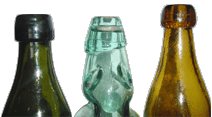 |
 |
| Applied String Rim |
- A sure sign of a really old bottle, this one c1760
- Highly unlikely that such lip finish will be found on bottles dug in South Africa unless from a really old dump!
- The String Rim was used to fix or tie the string which secured the cork.
|
 |
 |
| Aqua Glass |
- 95% of all bottles you may find manufactured prior to 1920 will be in the distinctive light green shading known as aqua glass.
|
 |
 |
| Blacking Bottles |
- Allthough common these are very attractive.
- Boot & Harness blacking and Stove Polish was sold in these containers for more than 100 years up until 1910.
- The salt glazed bottle on the left shows a lovely orange-peel effect. On the far right is pictured a very rare Doulton Lambeth miniture free sample 79mm.
|
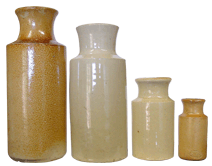 |
 |
| Blob Top |
- One of the four most common methods of closure on antique ginger beer bottles
|
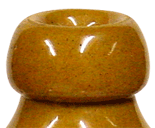 |
 |
| Boat Ink |
- A term given to ink bottles shaped (vaguely) like a boat.
- Note the indentations into which the old pens were placed.
- Boat inks occur in a wide range of colours from aqua (common) to cobalt extremely rare
|
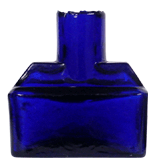 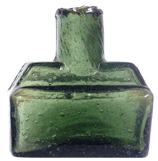 |
 |
| Bottoming |
- A digging term indicating when one has reached the bottom of a hole, i.e. the original level of soil upon which the dump is located.
- This hole dug in Pretoria "bottomed" at more than 7 metres and yielded very few items
|
 |
 |
| Burst Top |
- This lip finish, found on nearly all Boat Ink, Castor Oil and early Sauce / Relish bottles is a good indication of a bottle manufactured before 1910.
|
 |
 |
| Case
Gin. |
- Known by this term as they were delivered to bars in cases of 12, these bottles are amongst the most attractive glass bottles which a South African digger might come accross.
- Sealed Gin refers to a case gin bottle bearing a glass seal with the name of the gin distiller.
- The rarity / value of these bottles depends entirely on the seal.
- Pictured is an early (c. 1890) example of a "Pig-snout" or rolled-lip bottle bearing the "M.P. Pollen & Zoon Rotterdam" seal which features a hippocampus (sea horse).
- The clay pipes of "Blankenheyms Genever" which were freely issued to gin drinkers are frequently found in old dumps.
|
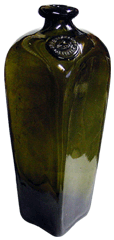
Click to show other examples
|
 |
| Castor Oil |
- Castor Oil is a generic term for bottles containing this substance commonly used in the belief that it could cure a number of maladies at the turn of the century.
- They are the most commonly found blue bottles and castor oil was packaged in the distinctive long necked bottles up until 1930.
- Many "older" citizens can remember having had castor oil forced into them during their formative years!.
|

Click to enlarge
|
 |
| Cobalt Blue |
- Various chemicals were added to glass to give it a distinctive colour.
- Most medicines, cures, poisons and castor oil bottles are in cobalt blue glass.
|
 |
 |
| Codd Bottle |
- On July 13 1886 a British inventor Hiram J. Codd registered a patent for a unique method of closure in a bottle using a glass ball and an "elastic" ring.
- Bottles using this method of closure are known, to this day as Codd bottles.
- Codd bottles will form a major part of this website as they are available in a vast number of factories, colours, shapes and sizes.
|
 |
 |
| Cone Ink |
- A name given to the distinctive shape of these ink bottles.
- Cone Inks are prevalent in Kimberley dumps with the white glazed versions traditionally having held red ink and being extremely rare.
|
 |
 |
| Cream Pot |
- As the name implies, used to transport and store fresh cream very collectable in the U.K.
- The pot on the left was dug from the Kamfersdam Dump and would probably have been brought out from the UK for its decorative value.
- Cream Pots are rarely found in SA, simply because fresh cream could never have lasted long enough to survive a 3/4 week boat trip from England.
|
  |
 |
Crown Cork
Crown Top |
- A method of closure on glass and ceramic bottles patented in 1892 and still in use in many countries.
- The right image shows the crown cork in place and the left image shows a bottle with a crown top.
|
 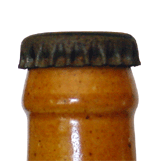 |
 |
| Dolls |
- Victorian and Edwardian children derived much pleasure from playing with dolls.
- In general the heads, arms and legs were made from porcelain and the bodies, cloth filled with sand, straw, sawdust or even rice.
- A complete section will be dedicated to dolls, some of which are of extreme beauty and all of which picture the aura of the time.
|
 |
 |
| Dwarf Ink |
- A logical name given to probably the most commonly found stoneware salt-glazed ink bottles.
- The name originates from a mention in a Doulton 1873 catalogue.
- The bottle on the left is a common variety, centre is a white-glazed version used for red ink and on the right a seldom seen version with neck pouring spout & potters mark.
|
 |
 |
| Galtee More Closure |
- A very scarce patented method of securing the cork in the top of a ginger-beer bottle by insertion of a steel spike/pin through a single hole in the blob top on the right side.
- Only 2 South African ginger-beer bottles used this patent: Reids Bloemfontein & W.H. & J Morgan, Port Elizabeth (the former bears the patent no. 4172 both from Price Bristol Potteries)
|
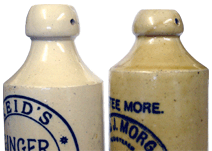 |
 |
| Ink |
- A catergory of collecting that probably contained the most diverse array of bottles both earthernware and glass.
- Ink was used in every Victorian household and packaged in literally thousands of different bottles.
- Among the most collectable and valuable bottles the items pictured here range from top left to bottom right from R 6 to R 70 000 (YES, you are seeing correctly... the drape pattern cone ink was lot no. 586 at a recent American auction)
- An upcoming section will be dedicated to inks which are named after their basic shapes i.e. boat, cone, cottage, pyramid, typewriter, figural...etc
- The avid ink collector is very concerned with colour and condition e.g. an aqua glass boat ink sells for between R 5 - R 10 whilst a brown glass boat ink in fair condition can fetch more than R 200.
|
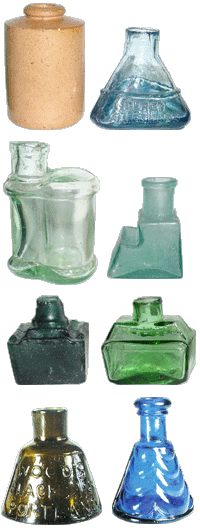 |
 |
| Insulators |
- "Jewels of the wire" as they are known by American collectors, are not readily found in South Africa but are extremely collectable overseas
- There are more than 20 websites dedicated to insulator collecting.
|
 |
 |
| Lightning Stopper |
- Also known as "swing stopper" or "swivel stopper"
- Amazingly this method of closure, still in use today, fits 100 year old bottles perfectly.
- Images 1 & 2 are original and image 3 a modern day Grolsch (Dutch) Beer closure.
|
   |
 |
| Lysol |
- A widely used antiseptic and disinfectant at the turn of the previous century.
- Originally manufactured by Schülke & Meyr, Hamburg and later by Lysol Limited London.
- Most bottles bear the characteristics Crosshatch pattern and Regd. No. 641401.
- Most commonly found is the honey brown variety with smooth surface and only the word Lysol in cursive script however these bottles are found in virtually every colour even cobalt blue.
- Lysol is remembered by some older folk as being very similiar to Dettol and was even used for gargling and eyewash.
|
 |
 |
| Match Striker |
- Also known as match holders these highly collectable pieces will have their own section in due course.
- Primarily used as advertising wares in bars they employed a number of interesting methods to hold and allow striking of the old (non-safety) matches also known as Lucifers.
- The one pictured was used to advertise Abrahams & Co direct importers. American Stores. Kimberley.
- Note the roughened texture of the cup which would have allowed for easy striking.
|
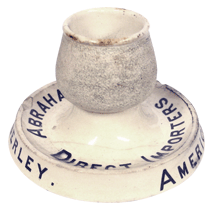 |
 |
| Milk Glass |
- A colour of glass seldom found and used primarily to contain creams and ointments.
- Tin or Zinc oxide was added to achieve this colouring.
|
 |
 |
| Mustard Pot |
- Used to store mustard which was a very popular condiment.
- Mainly of French origin. (have not yet seen one from another country)
- The one on the left is extremely rare, the one on the right probably the most commonly found.
|
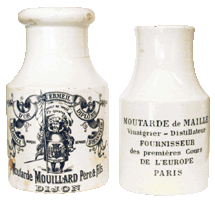 |
 |
| Nuttalls Patent. |
- A raised strengthening ring on the head of the bottle.
- Found only on A.T. Chambers & Son East London.
- Both bottles embossed Nuttall & Co / Makers / St Helens / 3759
|
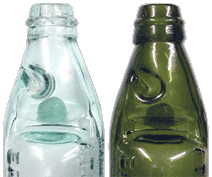 |
 |
| Ointment Pot. |
- A term loosely given to any small cylindrical wide mouthed porcelain container.
- The pot on the left would have had a paper label
- Ointment pots (including Holloway's) are very collectable and range from the plain and mundane to exotic and valuable.
|
  |
 |
| Pontil Mark or Scar. |
- The mark left on the base of a bottle after the removal of the method of holding the bottle during manufacture.
- A South African digger / collector has little chance of finding bottles with Pontil marks as these are all pre 1850.
|
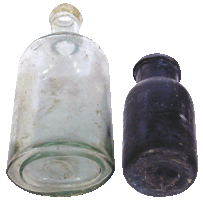 |
 |
| Registration Mark. (Diamond Shape) |
- A mark applied to glass and ceramic wares from 1842 to 1883.
- This mark and the numerals / numbers / letters incorporated in it indicated that the design had been registered with the Patent Office.
- An item may have carried the mark for many years after its initial registration date thus making the mark an unreliable dating method.
- The South African digger / collector will be fortunate to find anything bearing a diamond registration mark other thyan the "Square Top" red ink bottle pictured as diamond registration marks were replaced with registration numbers after 1884.
- This system is fully explained on pg 18,19 of Bottles & Bygones.
|

Click to view diamond registration
|
 |
| Registration Number |
- Between January 1884 and December 1909 a sequential numbering system was used to register designs.
- No actual date of manufacture can be inferred from a RD. No however only "OLDER" bottles carry these.
- These numbers are far more prevalent on crockery than bottles.
- RD. 1 - 19754 1885
RD. 19755 - 142300 1890
RD. 142301 - 248200 1895
RD. 248201 - 351202 1900
RD. 351203 - 385180 1902
RD. 385181 - 424400 1904
RD. 424401 - 471860 1906
RD. 471861 - 518640 1908
RD. 518641 - 534970 1909
|
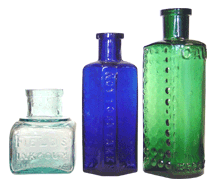
Click to enlarge
|
 |
| Salt Glazing |
- A surface glazing on stoneware obtained, not by dipped liquid glaze but by the chemical temperature action of vapours given off by wet coarse household salt being introduced into the kiln at the temperature height of the firing process.
- Advantage: It sealed porus substances with a relatively thin layer of glaze which did not hide or detract from intricate sprigs or bas-relief detail as well as leaving a rich orange / brown colour and pleasant texture.
- The beer jug on the left would have been slip-glazed at the top and bottom before salt glazing.
- Salt-glazing occours on a number of wares. i.e. stone gins on right, Doulton ware and even some ginger-beers
|
  |
 |
| Seltzer Water |
\
- A name formerly given to an aerated water beverage which has since been adopted to signify the distinctive shape of the bottle in which it first appeared.
- On the left a blob top dumpy seltzer bottle of Kops & Rawlings Johannesburg featuring their distintive eagle trade mark.
- On the right a crown top Crystal Springs Johannesburg.
- Both bottles dug at Forest Hill.
|
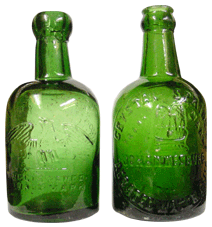 |
 |
| Shaws Patent |
- No.: 6875 / 07 Shaws Patent also known as "Sergeants Stripes" occur on a number of S.A. Codd bottles, the most famous of which are the Boksburg Mineral Waters, M & S Pretoria and Home & Colonial Johannesburg..
- Neck strenghtening by means of raised glass is also found on Ziman Bros and Binder Bros but not to be confused with the Shaws Patent as neither of these bottles bear the Patent No.
|
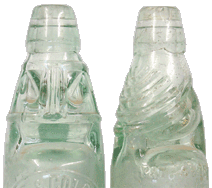 |
 |
| Sheared Lip |
- Slightly later than burst top, sheared lipped bottles made their appearance around 1910. The earliest versions were simply burst top ground down with later models being flame melted to give a smooth finish.
|
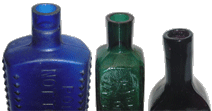 |
 |
| Sick |
- A term used to indicate the chemical reaction of heat, water, age, acids and weather on antique bottles.
- It is interesting to note that some forms of glass are more prone to sickness than others.
- In general, diggers, collectors and dealers prefer bottles in good condition.
- The bottles pictured would have been manufactured within a few years of each-other however they were dug in different locations indicating the effects of the elements upon them.
|

Click to enlarge
|
 |
| Sprigs |
- A sprig is a cast or moulded bas-relief of clay applied to the surface of a glazed container.
- Note the intricate detail of the sprigs on the delightful Doulton Lambeth mustard pot on the left.
- The sprig on the right, from a Doulton beer jug is unique in that it clearly shows a period bottle and leather drinking beaker.
|
 
Click to enlarge
|
 |
| Tears |
- Also known as "seed" or simply "bubbles" make some bottles more attractive and collectable.
- Tears are usually found in all hand made bottles and generally speaking the more tears the older the bottle.
|
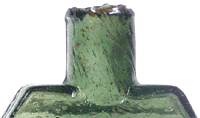 |
 |
| Virol |
- A preparation of bone marrow which replaced (in some applications) Cod Liver Oil at the turn of the century.
- These pots are a must in any collection and are found in at least 5 different sizes.
- The pot on the left is earlier (c.1895) and extremely rare. It bears the potters mark Port Dundas Pottery Glasglow.
- A massive ( 223mm ) example is known
|
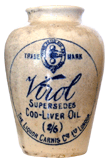 
Click for other samples |
 |
| Water Bottle Spout |
- Found mainly lying around on Boer War battle sites, these intriguing artifacts come in a variety of shapes, sizes and colours.
- They were used as the neck and cork recepticle on the canvas drinking-water sacks used by both sides.
- All of the spouts pictured were dug from the Kamfersdam dump at Kimberley.
|
 |














































